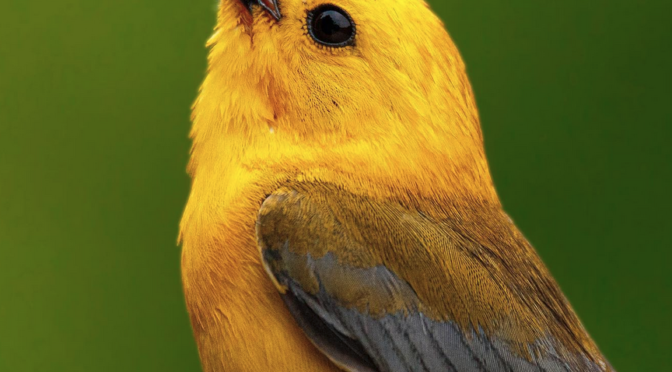By Sally Siko
Tag Archives: prothonotary warbler
Springtime Prothonotary Warblers in North Carolina
By Sally Siko
One of my favorite springtime arrivals is the Prothonotary Warbler. Not only are they flat out gorgeous, but they’re among the most friendly birds out there!
Although I’ve seen many over the years, none matched this experience I had with this handsome fella a couple of years ago while birding at Yates Mill Park in Raleigh, NC.
I’d spotted him flitting in the low branches adjacent to the bridge and decided to to give pishing (making a noise that sounds like a kiss whisper) a try.
Incredibly, the Prothonotary flew right up onto the railing of the bridge right next to me and continued to sing and even was relaxed enough to stop and preen every so often.
This same bird even landed onto the shoulders and heads of a couple of my birding friends too.
Absolutely the best warbler encounter I’ve ever had.

Prothonotary Warblers are best found in swampy areas in the central part of the state. They also favor habitats containing ponds or streams in mixed deciduous forest areas.
Soon the males will arrive, ahead of the females who will come in a couple weeks. The guys have a lot to do before their prospective mates fly in because it’s their job to select a nesting site, which will impress the females.
As cavity nesters, it’s the males job to find the best places to for the pair to raise a family. This means that during the first week or so the males will inspect many potential home sites, peeping in and out of holes in dead or decaying trees. When a couple of spots are selected, the males will start building multiple nests. Once the ladies arrive, it’s then up to them to choose the best nest site which the males have prepared for them.
Pretty cool huh?
These beautiful feathered gems arrived in the Tarheel State just a couple of weeks ago. Listen for their calls in the woods from now through late August.
Photo by @sally_siko of @bestlife_birding on my mighty mirrorless monster, the @canonusa #R5
By the way, I’ve added more than 80 new birding tour dates to my Best Life Birding trip schedule.
Check out the calendar below and book your next birding adventure with me today!
Prothonotary Warblers are here in NC
By Sally Siko
In North Carolina our wintering birds have quietly moved out and our spring migrants are trickling in.
This means that I’ve got to work just a little harder to see something new for the year so I decided to head into the east central part of the state since I haven’t birded much in this region.
Today I rolled out at 5am and 3 hours later found myself standing in the woods of the Croatan National Forest listening to the sweet songs of my first of 2023 Prothonotary Warblers.
And what a chorus it was!!
Although I managed to capture only one close up photo of a singing Prothonotary, I ended up counting 13 of these bright yellow beauties by the end of the morning which was pretty cool.
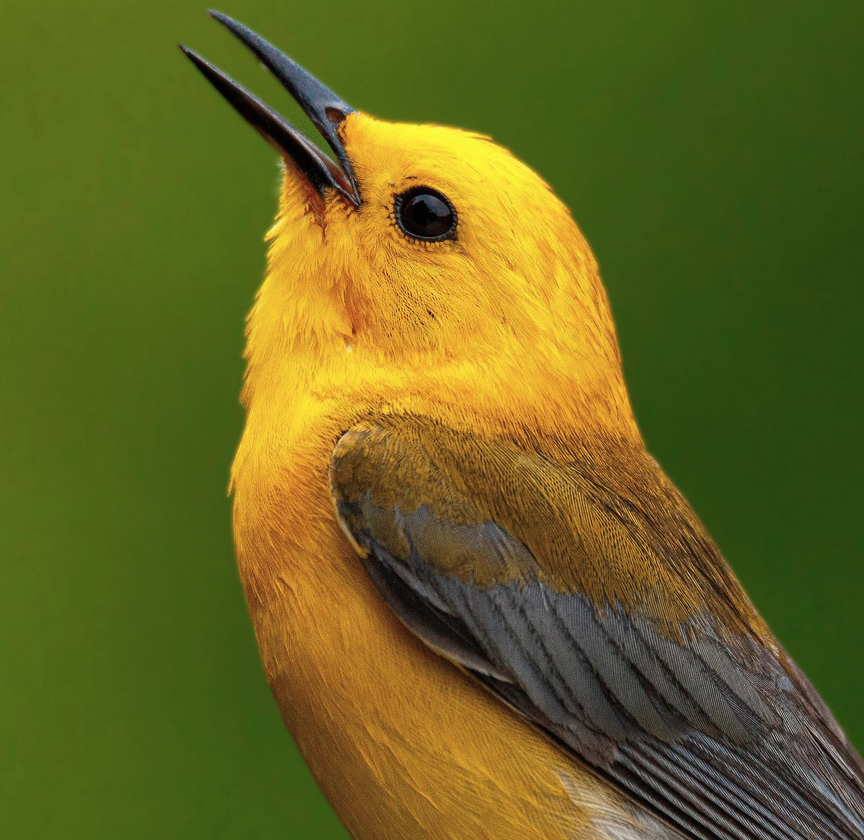
Prothonotarys are best found in moist habitats like swamps, bogs and marshes. They can also be seen in the brush and hardwood trees alongside streams, ponds and lakes.I found this beauty flitting through the trees along the shore of a swampy stream near Catfish Lake.There were plenty of insects flying around the water so it turned out to be good spot to sit and wait for the birds to show up. These lovely feathered gems usually arrive in North Carolina during spring migration in mid April so I was a little surprised to see so many early in the month.





As cavity nesters (one of only two species of Warbler that do this) Prothonotarys raise their young in unused Woodpecker nests or in other holes in trees.The male bird will start the process by building several starter nests in different locations to expand his territory and provide optional choices for his future mate.When the females come along a few weeks later, the male will show the her his array of nests then allows her to choose the one that suits her needs best.
Soon eggs will be laid with the next generation to follow.
For now though, the season has just begun and since the Prothonotarys will stick around through September you’ve got plenty of time to get out and see one this year.
*Big thanks to NC photographer Gray Whitley @grayphotojournal for the location recommendations!
Photos by @sally_siko of @bestlife_birding on my mighty mirrorless monster, the @canonusa #R5
Prothonotary Warblers change their appearance for migration
By Sally Siko
Autumn is here. Signs of change are everywhere if you know where to look. From flocking Canada Geese to molting plumage, if they hav’nt left already birds everywhere are preparing themselves for the migration journey ahead. Some changes aren’t so obvious, yet if you take the time to look closely you’ll be able to pick up on the seasonal cues even before cold weather arrives. Case in point, the beak color of a Prothonotary Warbler.
During the spring & summer this warbler has a bright black beak. In autumn and winter it is a tan color.The change happens quickly too!
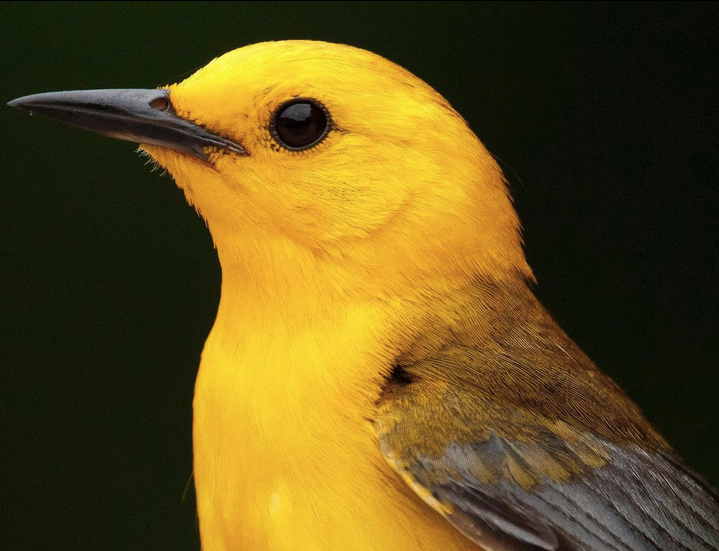

I took the series of photos (shown above) of a Prothonotary with the black beak (featured in the first photos) in June.
The second group of photos (below) shows a Prothonotary with the tan beak in late August. Can you see the difference?


But how does a Prothonotary Warblers beak change color?Their beak is covered in keratin, the same substance from which our hair and fingernails are made from.Under the beak’s layer of keratin lies a bony structure. While the bone makes up the foundation, it’s covered with a layer of living tissue which, in turn, is coated with a thin layer of see-through keratin. These living cells can change color, and the color shows through the keratin.Seasonal color changes to the living tissue in their bills occur due to fluctuations in the birds hormone levels and diet throughout the year.
Now that the Prothonotary’s breeding season has ended, their hormones levels have changed again so their beaks have returned to a light tan color. These beauties have mostly departed for their wintering grounds in Central America and northern regions of South America. No worries though, you can find them them here in the Tarheel state when they return in April.
Photos by @sally_siko of @bestlife_birding on my beloved full frame 50MP beast, the mighty @canonusa #5Ds
Prothonotary Warbler changes in autumn
Autumn will soon be here.
Signs of change are everywhere if you know where to look. From flocking Canada Geese to molting plumage, birds everywhere are preparing themselves for the migration journey ahead.
Some changes aren’t so obvious, yet if you take the time to look closely you’ll be able to pick up on the seasonal cues even before cold weather arrives.
Case in point, the beak color of a Prothonotary Warbler.
During the spring & summer this warbler has a bright black beak. In autumn and winter it is a tan color.
The change happens quickly too!
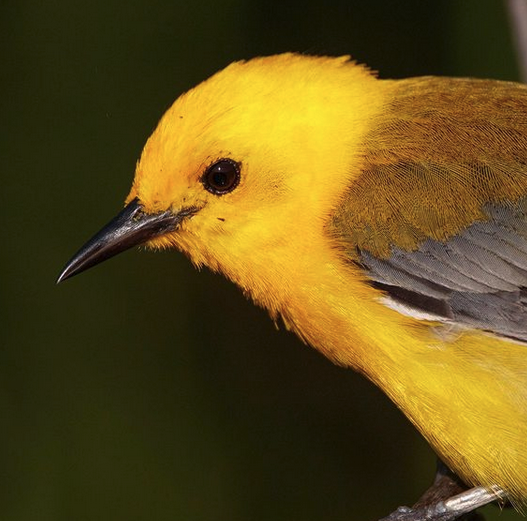
I took photo of a Prothonotary with the black bill (featured in the first photo) late last month.
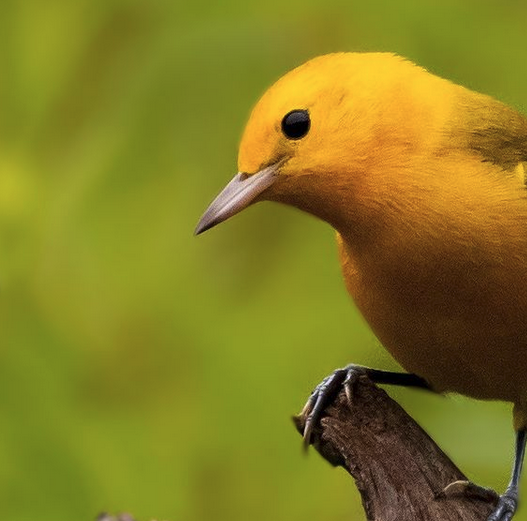
The second photo shows a Prothonotary with the tan beak just last weekend.
Can you see the difference?
But how does a Prothonotary Warblers beak change color?
Their beak is covered in keratin, the same substance from which our hair and fingernails are made from.
Under the beak’s layer of keratin lies a bony structure. While the bone makes up the foundation, it’s covered with a layer of living tissue which, in turn, is coated with a thin layer of see-through keratin. These living cells can change color, and the color shows through the keratin.
Seasonal color changes to the living tissue in their bills occur due to fluctuations in the birds hormone levels and diet throughout the year.
Now that the Prothonotary’s breeding season has ended, their hormones levels have changed again so their beaks have returned to a light tan color.
These beauties will stick around North Carolina until early September before heading south to their wintering grounds in Central America and northern regions of South America.
Enjoy them here in the Tarheel state for a couple weeks because they won’t be back until April.
Photos by @sally_siko of @birdwatching_nc on the mighty @canonusa
#R5 & #5Ds
A star of Yates Mill Park- The friendly Prothonotary Warbler
Prothonotary Warblers at the Weymouth woods sandhills Preserve
Another colorful bird to be on the lookout for at the Weymouth Woods Sandhills Preserve during the summer is the Prothonotary Warbler.
With that vibrant golden plumage, they’re cheerful sight indeed whenever your lucky enough to spot one hunting for a six or eight legged meal in the trees.

Prothonotarys are best found in moist habitats like swamps, bogs and marshes. They can also be seen in the brush and hardwood trees alongside streams, ponds and lakes.
I found this beauty near the beaver dam & creek while birding at the WWSP last weekend.
There were plenty of insects flying around the water so it’s a good spot to sit and wait for the birds to show up. (don’t forget the bug spray if you visit though lol)
These lovely feathered gems show up in North Carolina during spring migration in mid April. The males arrive first to establish their breeding territory’s and begin scoping out prime nesting sites.
As cavity nesters (one of only two species of Warbler that do this) Prothonotarys raise their young in unused Woodpecker nests or in other holes in trees.
The male bird will start the process by building several starter nests in different locations to expand his territory and provide optional choices for his future mate.
When the females come along a few weeks later, the male will show the her his array of nests then allows her to choose the one that suits her needs best.
Once the male wins a mate, the female will take over the rest of the nest construction, adding materials such as rootlets, plant down, and other soft grasses and plants to the nest cup.




While I was only able to photograph this single Prothonotary that morning, I did hear a second one calling out from the brush nearby. It would be great if they are mated pair and had a nest nearby.
I’m hoping to make another trip out to the Weymouth Woods Sandhills Preserve within a few weeks. Hopefully there will be some young Prothonotarys to see there hunting over the creek with their parents!
Photos by @sally_siko of @birdwatching_nc on the full frame beast of an SLR, the mighty @canonusa
#5Ds
Prothonotary Warblers are back at Bass Lake Park
My favorite little yellow guys are back, the Prothonotary Warblers!
I was so happy to show this sweet bird to my guests this past weekend at Bass Lake Park in Holly Springs NC.
It was super windy and a bit cold that morning so that’s why this Prothonotary’s feathers are a bit out of sorts. He looked a bit perturbed every time the wind blew as his feathers were ruffled with each gust.
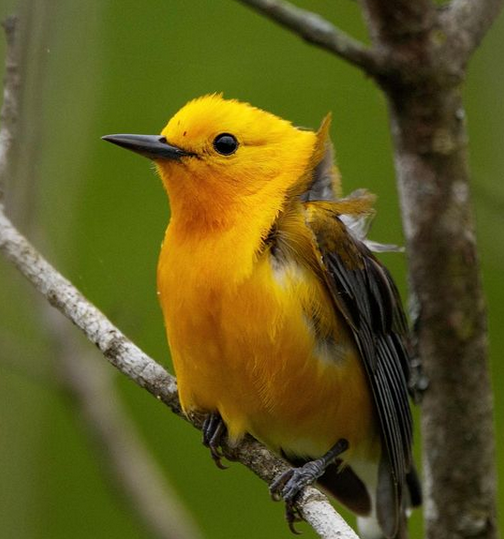
With that bright gold plumage, this species is easily one of the most striking birds you’ll find in the woods.
Prothonotary Warblers are named for the bright yellow robes worn by papal clerks, known as prothonotaries, in the Roman Catholic church.
The males sport bright-yellow heads and breast, greenish-yellow back, and bluish wings. The underside of the tail is mostly white, extending onto the undertail coverts.
When spread, the bluish upperside of their tail feathers shows large white spots.
Females look very similar to the males but are dressed in overall slightly muted green tones showing in their lovely yellow plumage.
Even though this handsome male had a few feathers out of place, I think he still looked amazing!


The Prothonotary Warbler will stick around N.C. from now until August so we’ve got plenty of time left to enjoy them this year.
I’m actually headed back out to Bass Lake Park later today on another birding trip and am hoping to have another crack at photographing this gorgeous feathered gem.
Wish me luck! 🙂
Photos by @sally_siko of @birdwatching_nc on the full frame beast of an SLR, the mighty @canonusa
#5Ds
A lovely male Prothonotary Warbler at Bass lake Park

Stoked to find this handsome male Prothonotary Warbler about 3 weeks ago at Bass Lake Park in Holly Springs, NC.!
I’ve been watching him since early April and it never gets old seeing his cheerful yellow face belting out a tune from within the maple leaves.
I recently came across fascinating study of the Prothonotary Warbler which found that nearly the entire species winters in a single small area in South America.
Not long ago, Biologists from the O.S.U. captured around 150 Prothonotary Warblers during their breeding season here in the southeastern U.S. and attached geolocators to the birds.
These tiny electronic devices use the timing of dawn and dusk to estimate birds’ locations once the biologists set them free.
When the warblers returned to their nesting sites the following season, the researchers were able to recover 34 devices that contained enough info for them to use for their study.
The data showed that regardless of where they bred, nearly ALL of the warblers spent their winter in a relatively small concentrated area of northern Colombia.

To give you an idea of just how amazing this is, the trip from Raleigh to northern Colombia is about 2000 miles!
That is one incredible journey for a bird that weighs about 4oz.
The fact that most of them end up spending the winter in one tiny area of the world is absolutely mind boggling!
Photo by @sally_siko of @birdwatching_nc
Canon 5Ds



